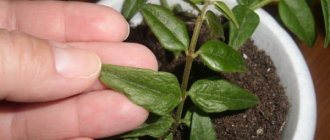Violet NK-Raffaello (N. Kozak)
Violet NK-Raffaello belongs to the genus of hybrid Saintpaulias of the Gesneriev family , also known as Uzambara violet.
The variety was bred in 2014 by a young but already famous breeder from Odessa Natalya Kozak . The name of all varieties created by her begins with the prefix NK, that is, Natalya Kozak. She collected Saintpaulias for many years, and in 2007 she decided to create new varieties herself.
Pollination was carried out on the mother violet variety EK-Sea Wolf in 2014 and in March 2015 the variety NK-Raffaello was presented at the exhibition.
EK-Sea Wolf.
The mother plant blooms with large, semi-double, wavy, bright blue stars . Petals with variable mesh. The leaf blades are dark green.
The bred violet NK-Raffaello is a medium standard with snow-white, double, huge, about 8 cm, flowers. The edges of the petals are very corrugated.
The flowers open with a green impregnation in the center , which, as they grow, gradually dissolves, giving the bouquet a unique freshness. They have a dense texture.
A neat exhibition rosette with medium-sized green leaves forms itself.
Attention! Over the 5 years of the variety’s existence, he never went into sports.
Who gave the world the luxurious “Babylon”?
Selective breeding of violets is a fascinating and painstaking work. You need to not only have a good understanding of pistils and stamens, but also have information about the genetic characteristics of plants, be able to choose the right “parents,” master pollination and other subtleties that allow you to obtain a new exhibition form.
The author of the “Babylon” violet is a Ukrainian breeder from Lugansk Svetlana Repkina. The name and varieties of the great lover of Saintpaulia are known not only in Ukraine, but also in Russia, the USA and other countries. In trade and information catalogs, Svetlana Repkina’s creations are designated by the abbreviation “RS-”. These letters are indicated as a prefix to the name of each variety.
Svetlana has been passionate about Saintpaulia since 1999, and her collection includes more than 500 varieties. As the author says, since 2001, a wonderful hobby has become a job. More than 100 bred varieties decorate exhibitions and homes of Saintpaulia fans, and the flower, named after the main city of Ancient Mesopotamia, is without a doubt one of the best creations of the breeder.
Home care
Caring for the NK-Raffaello variety is the same as for other Uzambara violets.
Conditions, pruning and hygiene
In order for Saintpaulia to feel good in the apartment, grow and delight with abundant flowering, you need to follow simple rules:
- Do not overfill and overdry;
- keep in direct sun;
- allow the air temperature to rise above 30°C.
Old leaf plates and stepsons must be removed so that the rosette does not thicken, but is smooth and beautiful.
It is necessary to ensure that dust does not accumulate on the leaves; to do this, the violet must be washed in the shower.
The Saintpaulia is put in place only after the leaf plates have completely dried. Otherwise, burns in the form of yellow spots may appear on the delicate leaves.
Proper watering and fertilizing
It is very important to maintain the optimal watering regime . If the soil is allowed to become too moist, the root system and stem of the violet will begin to rot and the plant will die. When the soil is overdried, the leaves of Saintpaulia begin to lose turgor, the flowers wither, and then the death of the root system occurs.
The NK-Raffaello variety, like other violets, can be watered:
- from above , in a thin stream along the edge of the pot, make sure that water does not get on the leaves;
- through the pan until the earthen clod is completely wet, after which the excess water must be drained;
- adult plants can be kept on a wick.
Wick watering.
Watering is carried out when the top layer of soil dries out.
Attention! Due to the fact that the NK-Raffaello violet grows quickly, it will not be possible to feed it until it becomes an adult. Saintpaulia has to be replanted once every 2-3 months, so it does not have time to use the nutrients.
Adult specimens should be fertilized with specialized fertilizers marked “For violets . The first application of fertilizers is carried out 3 months after transplanting Saintpaulia into fresh soil.
If the planting substrate does not contain organic fertilizers, Saintpaulia can be fed within a month.
Lighting and temperature
One of the prerequisites for growing healthy NK-Raffaello violets is lighting. But there shouldn't be a lot of it.
As soon as the peduncles appear, it is better to reduce the light intensity, otherwise you will not get a full cap flowering - the short peduncles will be hidden under the upper leaves.
The NK-Raffaello variety is ideal for northern windows and growing on shelves with one fluorescent lamp.
The optimal temperature for keeping this flower is 18-23°C. The cooler it is, the longer the flowering period and the larger the buds.
Effect of air humidity
Increased air humidity helps Saintpaulia survive at high ambient temperatures. To survive the heat, air humidity for young violets should be 50-60%; for adults, 30-40% is enough.
To raise it, you should not spray the plant , as this will create a short-term effect and may spoil the decorative appearance of the leaves and flowers.
A more lasting result is achieved by placing the pot with the plant on a tray with damp expanded clay or moss.
It’s even better to place plastic bottles with frozen water between the violets. This simultaneously reduces the temperature and increases air humidity, while preventing damage to the flowers and leaves of Saintpaulia.
Reproduction methods
The NK-Raffaello variety is propagated in the same ways as all plants of the Gesneriev family:
- stepchildren;
- sheet plates;
- cuttings;
- children who grew up on hemp after the rejuvenation of the mother plant. At the same time, you don’t have to be afraid that the violet will go into sports.
Soils
The substrate for Saintpaulia should be light, loose and breathable.
Important! The basis of the soil for planting the NK-Raffaello variety is high-moor peat with the addition of river sand.
Nevertheless, Saintpaulia can also be planted in ready-made soil from the store marked “For violets .
Ready-made soils for violets.
If you make soil based on soaked peat tablets or coconut substrate with the addition of river sand, perlite or vermiculite, then you should add a little dry ground horse excrement as a nutrient organic matter.
Before planting, the soil is calcined in the oven for 30 minutes and sifted.
Rules for transplantation and rejuvenation
For an adult violet of the NK-Raffaello variety, a pot with a diameter of 7 cm . It is best to take a plastic one, since in a ceramic one the root system will either overheat or become very cold.
Expanded clay or small pebbles must be poured onto the bottom Then some prepared soil. If the plant grows on a wick, then drainage is not required.
If this is a planned transplant , then:
- Before the procedure, the plant needs to be watered a little - wet roots are less injured;
- Remove the Saintpaulia from the pot and carefully shake off the old soil;
- Remove the lower leaves, sprinkle the removal areas with activated carbon;
- Place the violet in the pot so that the bottom row of leaf plates of the rosette does not reach 1-2 mm from the edge of the container;
- Fill with soil, tapping the pot on the table so that the soil fills all the voids;
- Spill thoroughly, let the water drain completely, cover with a bag or plastic bottle, and place in a bright, warm place for several days.
In the case when the violet has become large and the bottom of the trunk is left without leaves, the plant must be rejuvenated . To do this, without removing the plant from the pot, cut off the top of the Saintpaulia with scissors.
Advice! Sprinkle the stump remaining in the pot with activated carbon. It will subsequently grow into children that fully retain the varietal characteristics of the mother violet.
Remove the bottom layer of leaves from the crown, giving it symmetry. Using a sharp, disinfected knife, carefully scrape off the woody layer and let it dry for a few minutes. You can root the crown:
- in the ground;
- in water;
- in wet perlite.
Rooting in water.
Stick the violet into a glass with soil or perlite. Place in a plastic bag for 3-4 weeks. After the roots grow to a length of 2-3 cm, transplant the Saintpaulia to a permanent place of residence.
Conditions for successful growing at home
All violet plants are capricious, and Babylon is no exception. First of all, they are very demanding about the conditions of their maintenance, and only then about their care.
Did you know? The cooler the room in which the Babylon violet grows, the richer the color will be in the “strokes” on the flower petals.
Location
Those who have already encountered the cultivation of Babylon note that the flower feels good on window sills or shelves located near windows. Only the window should not face the south side and drafts should be avoided. Flowers will feel great in the kitchen, where there is always enough light and high air humidity.
Lighting
Violets love light, but only diffused and soft. Direct sunlight easily burns their foliage. Signs of a lack of lighting will be a faded and lethargic appearance. In addition, the leaf plates will change orientation from horizontal to vertical, so on cloudy days, especially winter ones, when daylight hours are short, it is necessary to organize additional illumination with fluorescent lamps until 13–14 hours.
Temperature and humidity
Although in the wild violets grow in temperate climates, they love warmth. The temperature that is comfortable for them is +20...+25°C, which must be maintained all year round, which is very difficult to achieve in urban conditions.
Important! For Babylon violets, it is permissible to lower the temperature to +12°C, but for a very short period and at night. If the cold lasts for a long time, the leaf plates will be burned.
Features of flowering, growth and reproduction
At home, under optimal conditions, the NK-Raffaello variety initially grows quite quickly - small violets have to be transplanted into a larger container every 2-3 months . The first flowering occurs after 8-10 months.
Transfer of varietal characteristics
There are no difficulties in propagating the NK-Raffaello violet . Since Saintpaulia does not go into sport, there is no need to wait for it to start growing stepsons; a leaf plate or cutting . But if you grow a violet from a stepson, flowering will occur faster.
Planting material is removed from the mother Saintpaulia or cuttings after their rosettes of children have reached a diameter of 1.5-2 cm. They are placed for rooting in soil, water or perlite, first treating the bottom of the trunk with “Kornevin”.
If rooting was carried out in a substrate, then the plant is transplanted into a larger pot when the roots completely entwine the entire earthen ball. We must remember that the container for the violet should be 1/3 of the diameter of the outlet.
Optimal pot sizes for violets.
When rooting occurs in water or perlite, then after growing roots, after 1.5-2 months, Saintpaulia is transplanted into small 50 ml cups to build up a full-fledged root system.
Flowering variety
The violet blooms most readily and blooms longer when the temperature at night is +18°C and during the day +23°C. Flowering lasts up to 2 months , which is quite a long period for white-flowered Saintpaulias.
Under optimal conditions, a cap of huge snow-white flowers blooms above a small rosette. Heat primarily affects flowering - the buds become smaller and do not last long.
Attention! Saintpaulia's peduncles are short, capable of holding up to 5 huge flowers. To ensure that the peduncles stretch out and the flowers do not hide under the upper leaves, the violet is placed in a more shaded place or the light output is reduced while the arrow is growing.
What is the collectible “Babylon” famous for?
If you are seriously interested in the Babylon violet, the photo and description will allow you to get to know the plant better. Like any hybrid and wild Saintpaulia, the variety belongs to the Gesneriaceae family. Its closest relatives are streptocarpus, nematanthus, gloxinia and other plants popular in home floriculture.
The leaves of “Babylon” are large, moderately green, like any violet, leathery, abundantly strewn with small fibers. They form a fairly large rosette. The edges of young leaves are initially tucked in, but as they grow, they straighten and acquire the usual oval shape.
The main advantage that arouses the admiration of “Babylon” fans is the gorgeous semi-double flowers with elongated petals. At the peak of growth, their diameter reaches 8 cm, which is not typical for most violets. The main color is white with rich cherry strokes.
Looking at the Babylon violet in the photo, one gets the impression of abundant flowering. To be fair, it is worth noting that this is not the case. Its peduncles are sparse, strong and short, which is not surprising given the size of the inflorescences. Sometimes the buds are hidden under the leaves. Therefore, before flowering they need to be carefully released.
Like any hybrid variety, “Babylon” has its own characteristics that are common to the group of flowers of a particular breeder.
Don’t flood, don’t catch a cold, don’t forget to communicate
It's nice to grow a violet from one small leaf. If you have friends who are happy owners of Babylon, ask for a couple. Place in water, wait for roots and plant. There is nothing complicated in caring for violets if you follow the basic rules:
- in large containers, Saintpaulias grow to the detriment of flowering, so choose a small and shallow pot;
- you can buy ready-made soil for violets or take turf soil, peat and sand in a ratio of 4:1:1;
- Do not allow flowers to be exposed to direct sunlight;
- violets do not tolerate waterlogging of the soil, wither and die quickly;
- they get sick in drafts, become fattened from excess fertilizer and lose their decorative properties.
Having become acquainted with the “Babylon” violet, take one important piece of advice from Svetlana Repkina: pick up the pot more often, talk to your flower, and it will repay you with gratitude, luxurious flowering, and give a lot of positive emotions.
Subtleties of content
As admirers of Svetlana Repkina’s violets note, her plants are excellently adapted for both window sills and for growing on shelves. And this, by the way, is important when creating interior designs.
The first flowering of a young violet “Babylon” is simply pleasing, and subsequent ones amaze with their beauty when the plant reaches its full potential. Another interesting pattern: in cooler conditions, Svetlana Repkina’s Saintpaulia blooms especially brightly.
It is a slow-growing hybrid. To wait for flowering, you will have to be patient and, of course, remember the basic rules of violet agricultural technology.











